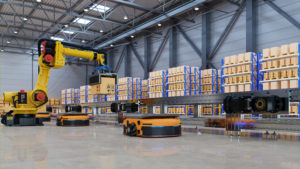
The supply-chain management function has shifted its emphasis from traditional logistics to more advanced planning processes. This is mainly because businesses are adopting digital transformation and data driven technology for their existing logistics and sales operations.
Industry experts refer to this as “Industry 4.0” or the “fourth industrial revolution,” where physical production collides and integrates with new technologies. The digital revolution taking place within the supply chain allows for better automation and inter-system integration.
According to McKinsey, organizations that actively research and apply digitalization to their supply chains can expect to enhance their annual bottom line profits at a faster rate than their annual sales growth. When operational changes are combined with digital applications, the results create lasting performance gains.
Cloud-Based Systems
Cloud-based manufacturing is a model that can be used to access a variety of scattered resources on-demand to create temporary and programmable combined tech-physical production lines. This model would increase efficiency, lower product lifecycle costs, and allow for optimal resource allocation. The data extracted from the supply chain is now generated by a variety of technical tools, manufacturing processes, and other elements. Without digitalization, constant issues may arise relating to the variety and incompatibility of the machines and devices.
Cloud systems are critical components of Industry 4.0 because they solve this problem and allow the usage of the same data on many devices. Data can be moved quickly without any software or hardware issues, and machines and devices can connect without any protocol limits.
The integration of Big Data

Bridging all data together, popularly known as “Big Data,” uses signals such as sensors, vibration, and pressure to acquire data. In addition, historical data may be collected for future data processing as well. With the fast growth of the internet, traditional database technology may struggle to store, manage, and analyze vast amounts of data. For this reason, big data technologies use new ways to get personalized data, provide accurate information and new insights, and allow faster extraction of information in order to make informed decisions.
Role of the Internet of Things (IoT)
A series of items are connected to the internet, linked with each other; each of these items has its own unique identifier (UID) and IP address. This allows each component connected to the internet to be easily recognized. IoT is a crucial component for a supply chain business that can be applied in a multitude of ways. These businesses can employ IoT to communicate and exchange information in far more effective ways than those that do not use it.
Era of cyber-physical systems [CPS].

In the present context, cyber-physical systems mostly operate in semi-autonomous environments. They are a development that links the physical and digital worlds together through the use of technology, computers, and the internet. CPS is viewed as the next step in the design of supply chain production and transportation activities. The basic idea is to improve the overall performance of dispersed and autonomous systems that operate together. These sensor-based systems employ internet services to track movements in the real world. Robots and self-driving cars are well-known examples of CPS used in modern supply chains.
Conclution:
The real impact of Industry 4.0 and digital transformation is still difficult to fully comprehend as it takes a long time for new technologies to spread across all industries. At this point in time, we can only point to specific examples of success, but learning from them has revealed how the new technology may revolutionize the whole supply chain.
